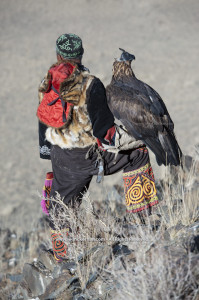Travel Blog — Mongolia
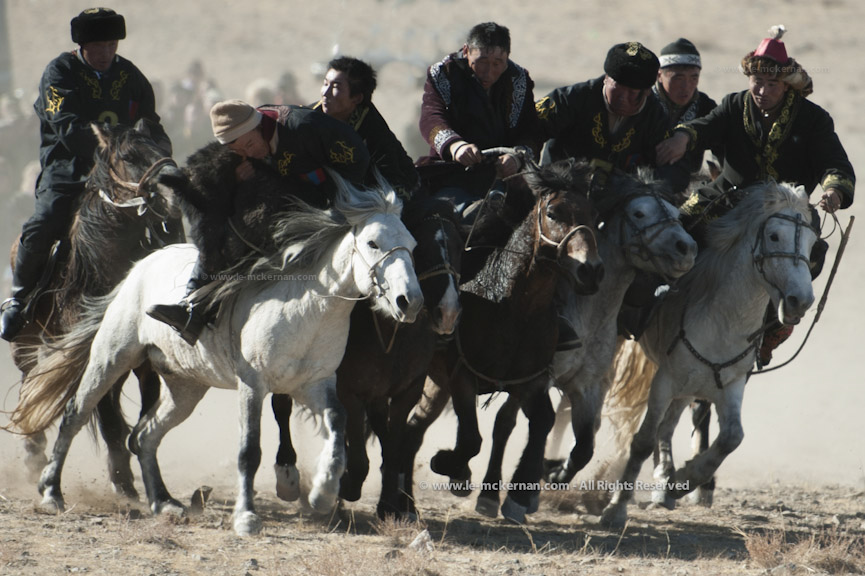
‘Oh, bugger‘ was my first thought as I went flying thru the air. ‘Ouch‘ was my second thought as I landed on the painted rocks which served to demarcate the boundary separating the spectators and the players. Buzkashi is a horsegame typically compared to polo — but the former is played with a ball whereas the latter is played with a headless goat carcass. The other difference is that polo is typically considered a gentleman’s game whereas buzhashi is a seriously rowdy, highly competitive and very fierce spectacle. Nonetheless, I thought I was relatively safe as I was seated in a place of honour. I was on the front bench alongside some senior and distinguished Eagle Hunters. Surely these boys won’t want to run over their grandfathers, or so I thought … Not so as these boys take buzhashi very seriously and the locals know this. So, as a wall of four galloping horses headed towards the benches, the ‘grandfathers’ were swift and nimble and avoided the horses. I, on the other hand, went flying thru the air as the horses (and riders) ignored the painted rocks.
As I dusted myself off, my third thought was on whether or not I’d managed to get ‘that perfect shot’ of the thundering horses coming towards me. But, before I could check the images from my camera, I noticed that I was suddenly surrounded by the locals. “OK? OK?” they all asked with their eyes and kind gestures. “I’m OK.” I smiled and gave them the ‘thumbs up’ and tried to assured them that all was fine but they still seemed genuinely concerned. “OK? OK? Sit, sit.” And then, more people came up to check that I was unhurt. It was then that I realised that there was some secret or unspoken code of hospitality at stake. The locals were appalled that a visitor was potentially injured. I tried to assuage their concerns by resuming normalcy and taking more photos of the game. (Note: nothing stops buzhashi.) But the crowds remained. And then the penny dropped — the locals were now forming a human shield around me against future harm.
I was so charmed by their generosity that the game no longer became important to me. Instead, I started to take photographs on my iPhone of the kids protecting me. I used the Hipstamatic application on the phone to create interesting images and the kids were thrilled to see their portraits. And, before I knew it, the game finished. In the end, I didn’t get that ‘perfect’ shot. Nonetheless, I had something better — I had the warmest memory of the kindness and concerns shown by ordinary Mongolians towards me during the game. It was an endearing and unforgettable moment.
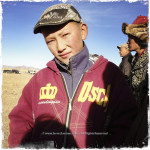
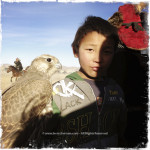
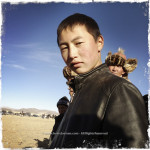
The bitter and biting cold was another unforgettable memory of Mongolia. We did our research beforehand and packed for all seasons. During the day and under the blazing sun, it was warm and bright (sunblock and hat mandatory). But, on a clear and star-filled night, it was brutally cold. On the first night, I had my woollen stockings plus two layers of thermals whilst tucked inside an Arctic sleeping bag and under a thick wool blanket (loaned to us by the family we were staying with). During the autumn and winter, the family moved into their mud-brick winter house; during the summer, they use their ger (a Mongolian yurt) as they move their herds to summer pasture. We were sleeping in their summer ger — and it provided little warmth. Every night, the host lit a dung fire in the ger’s central stove, but, the dung fire burned too quickly. Within 30 minutes, the ger was cold again as the biting winds found every holes and gaps in the thin walls. On the second night, I added more thermals but I still found it uncomfortably and incredibly cold. It was so cold that it was difficult to fall asleep. In fact, it was so cold that the decision to remain inside the sleeping bag and shiver/suffer the cold (and pray that I’ll eventually fall asleep) was better than to unzip the bag and expose myself to even more horrible coldness in order to put on more layers. Each night thereafter I added more layers until I looked like the Michelin man. It was only on the seventh and final night in the ger that I finally had a warm and comfortable sleep — at that point, I had: 1 woollen stocking, three pairs of wool/cotton socks, three thermal pants, three thermal shirts plus a double-thickness cotton shirt plus 1 cotton rugby shirt whilst tucked inside a sleeping bag under a wool blanket and a sheepskin coat (also on loan from the family) used as another blanket. And this was in early October! I cannot imagine the cold during the deepest and darkest winter.

‘the leaky ger’ at night
Manaa, our host, is a champion eagle hunter with a beautiful wife and 11 grown children. Most of his fledglings have either moved to the village and/or are boarded at school. Even so, the house is rarely quiet. Mongolian hospitality is a never-ending pot of milk tea and a continual stream of neighbours and visitors. During the weekend, the school kids return and the house teems with life. In addition to the kids, the house is home to two golden eagles. The elder eagle has been in Manaa’s care for 5 years and is quite docile. The other bird is newly acquired and still very wild. As such, it is kept in the kitchen so that it would acclimatise to the sounds, smell and sight of humans.

our host with his trained eagle
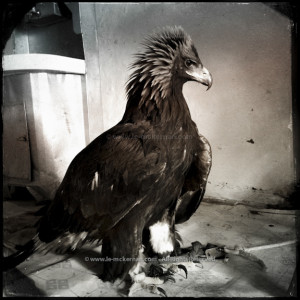
a wild eagle in the kitchen
The eagle hunters only use female birds as they are significantly larger than male birds. Furthermore, they only use eagles that have already been trained to hunt by their mother. The hunters then train the birds to hunt for them. The first step is to teach the young eagle (typically at age 1) to accept food (a poor bunny in this case) from the eagle hunter. Once the bird accepts the eagle hunter as it’s ‘master’, then the eagle is taken outside and tethered to a rope and taught to catch a lure and then fly back to it’s master. We were told (via our translator) that Manaa has trained 6 eagles successfully in his career and that it would take approximately 20 days to train a smart eagle. Once an eagle is trained and successfully captures an animal, the eagle hunter would reward it by giving it the warm liver of fox/rabbit/marmot. A good hunting eagle is typically kept for ten years before it is released back into the wild so that it could breed. At the start of the breeding season on the eagle’s 11th year, it is taken to the top of the highest nearby peak and released. We were told that it is extremely rare for a released bird to return back to it’s master’s home. But if it does return, then it is taken further afield and released again.

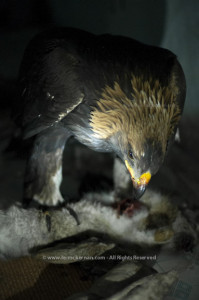
We were in western Mongolia specifically to see the two-days Golden Eagle Festival. This is a public-private enterprise between the local government and a tour group (Nomadic Expedition) to showcase and to preserve a local tradition as well as give an economic injection into a sleepy part of Mongolia. We wanted our tourist dollar to stay in Mongolia and therefore opted to travel independently. We used a local agent (Blue Wolf Travels LTD — which we would NOT recommend) to book our private gerstay, our translator/guide, and our driver. The plan was to arrive before the crowd and spend two days exploring the region first. Then, we would attend the festival followed by two days of horse riding & hunting with the eagle hunters. And our seventh and last day in western Mongolia would be a rest day. Very little went according to plan because Blue Wolf was hugely disorganised. In fact, the only days that went perfectly were days that Blue Wolf was not involved in the logistics. (I would recommend avoiding Blue Wolf — please see the specifics in my review of the company.)
Blue Wolf malarky aside, we thoroughly enjoyed visiting western Mongolia. We loved staying with Manaa and his family. We ate with the family and shared their communal plates. Like the locals, we dropped into other people’s houses to say hello and were supplied with endless milk tea (full fat and salty). The evening entertainment was based on songs and storytelling. Despite their hard lives, Manaa and the others know how to live to the fullest. On the last night of the Eagle Festival, Manaa and his neighbours celebrated the local village’s festival successes until 5:30 AM. The celebration only ended because it clashed with the start of his morning chores. His animals needed care so he exited from the party and took the birds out for their morning exercise and then he tended to the cows, yaks, horses and goats.
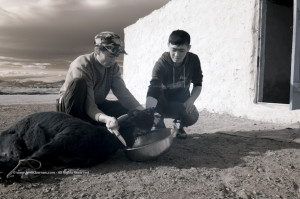
Manaa’s sons kill a goat for dinner

a typical dinner scene: mutton and potatoes in the communal plate (center of the table), endless cups of tea, and Mongolian vodka.
Travel to western Mongolia required a robust constitution. Prior to our arrival, I’d spend weeks trying to hunt down the elusive typhoid vaccine. The global manufacture’s recall resulted in a very tight supply and I was told by numerous medical centres and hospitals in Hong Kong that the vaccine could not be purchased in HK for love or money. Many false leads later but thanks to a tip from the HK government, I found a Christian medical clinic that had the vaccine in stock. And, it was needed!
In western Mongolia, one did one’s ablutions in the open fields. In addition, the primary source of fuel for cooking was animal dung. And, whilst there was a washing basin the kitchen, the water was from a nearby well. Furthermore, the cook (from Blue Wolf) didn’t always wash her hands after filling the stove with the quick-burning dried dung. And so we were incredibly grateful that we were fully vaccinated up for all types of bugs and ailments before we arrived.

What we didn’t anticipated were the bruised elbows and sore back from bouncing along the rocky steppe and dirt paths. There is ‘off roading’ and then there is ‘Mongolian off roading’. We crossed boulders-ridden riverbeds, climbed steep mountain sides, and tracked across stoney and sandy desert paths in an old Soviet jeep. Coming from a super-condensced city, it was a joy to be able to stretch one’s eyes towards the horizon. But, the joy was quickly replaced when we realised that getting from point A to point B required hours of travel.
Mongolia was truly and dramatically vast. Thankfully, Bruce downloaded some old Soviet maps and overlayed these maps onto Goggle Earth and he uploaded these files onto his GPS device. Thus, we were able to see our progress in real-time in Mongolia. Once we were travelling some distance to see a stone monolith. A quarter of the way there, the driver stopped the car (twice) to inspect something. At this point, we checked Bruce’s GPS device and realised that we were in the middle of absolutely nowhere. Furthermore, we were in the Mongolian desert and had no spare water (and no spare blankets in case we got stuck there at night). And, we were so remote that there was no mobile phone reception. And to make matters worse, due to a Blue Wolf screw-up, we had a change in the itinerary which meant that no one knew our true destination. So, if the car broke down in the middle of Nowhere Mongolia, we would truly be 100% buggered. At this point, Bruce made the right decision and cancelled our outing to see the stone monolith.
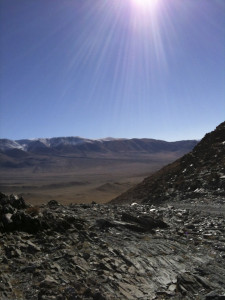
Unfortunately, this curtailed roadtrip was not an isolated incident as the local agent was completely ‘canat’ (a newly invented adjective!). Thankfully, we had a very good driver and translator/guide which helped mitigate our losses. But despite losing time going to the wrong places, etc. we could not stop enjoying the endless natural beauty and stunning landscapes.

The absolute highlight of the trip was the Golden Eagle Festival. At approximately 10 AM, it started off with a parade of the Eagle Hunters (my guestimate was that approximately 30 Eagle Hunters participated in the 2013 festival). The first two hours of the festival was vicious — every Westerner (and his dog) had multiple cameras, smartphones, video cameras, binoculars, etc. And so before the official eagle competition started, the photographers (myself included) jostled and competed amongst ourselves for ‘the photo opportunity’. It was an ‘Eagle Hunter paparazzi’ on an epic scale. Thankfully, the photo mania calmed once everyone realised that the festival spanned two days, there was plenty of space to spread out, and by stepping on top of each other, no one was going to get a good photograph.
Day 1 was to test the eagle’s response to it’s master’s voice. One by one, the eagle hunters called out to their eagles. The eagles were released from a high peak and they were timed. The quickest one to perch onto it’s master’s arm was the winner. On Day 2, the test was on the eagle’s ability to catch a moving bait (dead fox/rabbit dragged behind a horse). Again, the eagles were timed and judged on speed and effectiveness on landing the bait. The eagle competition ended by midday on Day 2. That afternoon was an opportunity for the local boys to demonstrate their horse riding skills as well as compete against neighbouring villages in robust games of buzhashi.
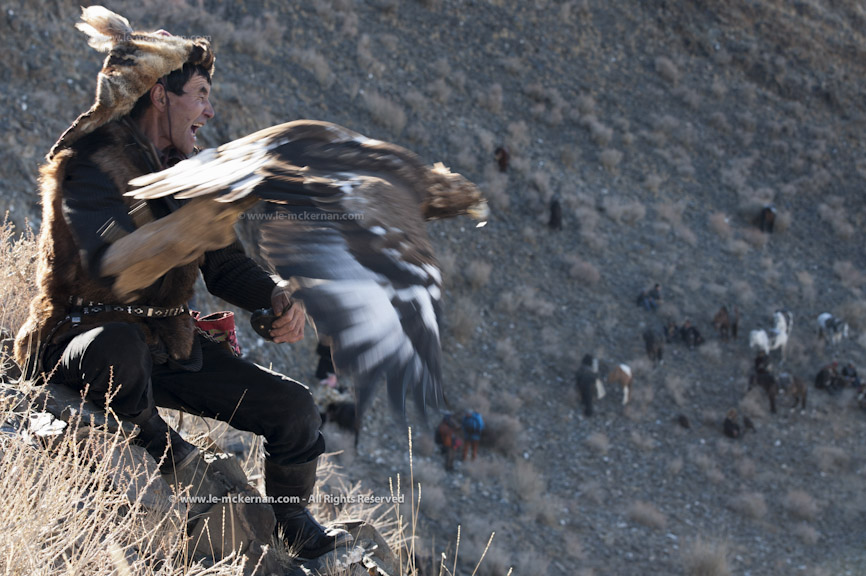
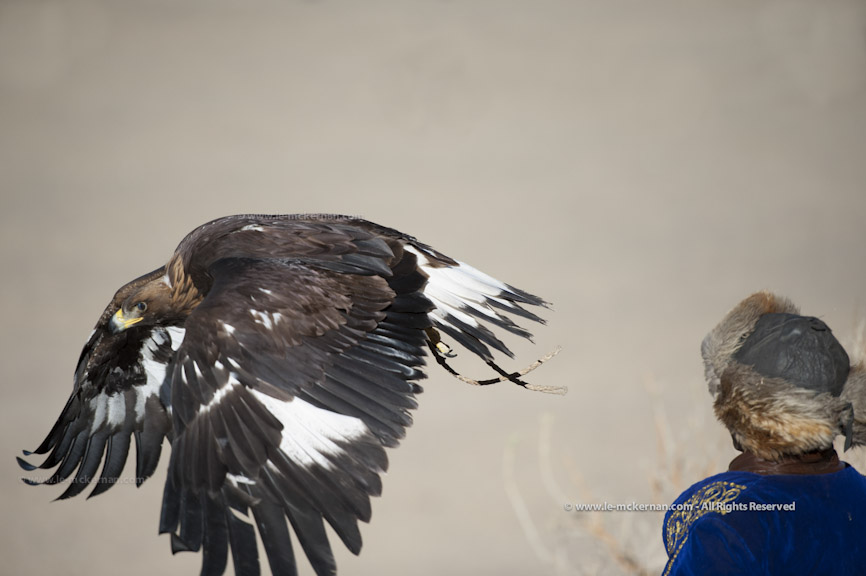
Bizarrely, some of the eagles determined that photographers were more desirable than the dead foxes/rabbits. Two photographers were “attacked” — and one was actually hunted by the eagles twice! (Bad eagle karma?) Thankfully, neither the photographers nor the birds were injured.
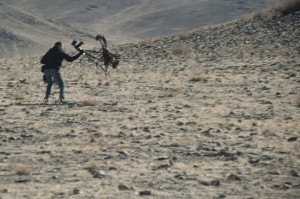
photographer used his tripod to defend himself from an eagle
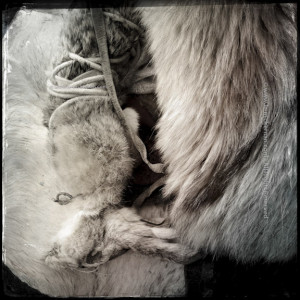
the bait …
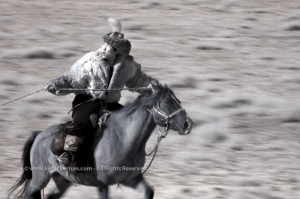
the horseman luring the eagle with the rabbit bait
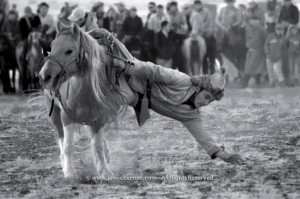
picking up a small parcel on the ground whilst on a moving horse
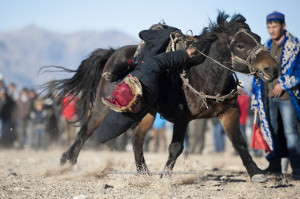

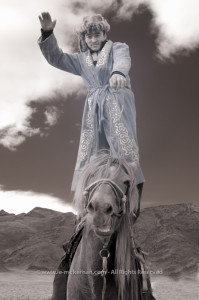
show-off !

Ouch! Player is knocked off this horse during a game of buzhashi
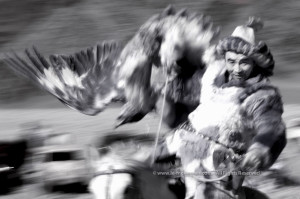
Despite the bitter cold at night, the harsh travelling condition and the many frustrations and disappointment with our local travel agent, we thoroughly enjoyed visiting Mongolia and would highly recommend the Golden Eagle Festival in Olgii/Ulgii. If possible, we would recommend avoiding the the tourist gers and hotels. The best way to get “under the skin” of a place is to do a homestay or a gerstay with a local family. Our recommendations are posted below.
If you have questions, please do not hesitate to contact me at feedback@le-mckernan.com. Happy travels!
BTW — the first image below is the image I’d managed to take before getting knocked over. The second image shows one of my “human shields” trying to get my attention to warn me about the approaching horses. It still tickles me pink when I reflect on the kindness and care of the locals!

before …
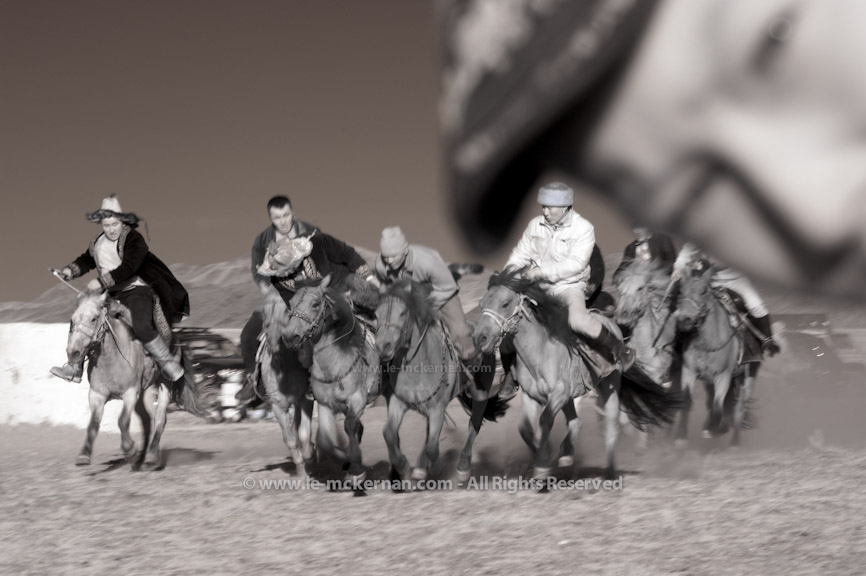
after …
For additional photographs, please check out this link.
Travel Tips:
For anyone interested in travelling to Western Mongolia, our suggestions are:
- Pack well and pack wisely. Mongolia certainly has the extremes in temperature and in condition. And, don’t assume that your host will have sufficient supplies.
- If possible, pack light — especially if you are flying into western Mongolia. Aero Mongolia is fastidious about charging extra for excessive baggage weight (including carry-ons)! This is a cash cow for them and they will ( rightly ) milk it for all that they can. As a workaround:
- You could stuff your coat pockets with your heavy carry-on items when you check in (they don’t make you weigh-in your coat). Once you have your boarding pass, you can then put the heavy stuff from your coat pocket back into your carry-on bag.
- Some people are posting their sleeping bags, etc. to/from Mongolia via DHL, FedEx, etc. to avoid paying the stiff excessive baggage fee.
- Mongolia is becoming an ever popular travel destination and we know firsthand of two incidents in which people were ‘bumped’ from their gers due to double-booking. During the eagle festival, demand easily outstrips supply. This is where you need to work closely with your local agent and confirm (and then double/triple confirm) the arrangements.
- Work only with reputable agents or one that comes recommended. We met another traveller who booked her arrangements by email with a local agent and only had his mobile number as a contact. When he failed to pick up her messages, she had no other way to get in touch with him. She then had to book herself into a dinky hotel at an exorbitant rate.
- The Lonely Planet publishes a comprehensive ‘what to pack’ list. In addition to their list, I would also suggest:
- Lots of baby wipes or deodorant paper. Unless you are staying in a hotel or in a tourist ger, bathing (especially in the colder months) would be difficult.
- For the sake of a comfortable bottom, bring along the toilet paper that you normally use at home.
- For the ladies, I cannot recommend enough either http://www.freshette.com or GoGirl. You can typically find these in any camping or outdoorsy shops.
- Plastic bags! I know that they are environmentally evil, but, a few spare plastic bags are a godsend under the right circumstances such as: to serve as a garbage bag, a puke bag (it happens!) or just to separate the clean from the not-so-clean clothes, etc. (If you are staying in a rural area, then bring your garbage into town at the end of your trip and dispose of this responsibly.)
- Pain medication (for sore backs), hand/feet warmers (the type skiers put inside their gloves and shoes), and a few extra pairs of socks.
- If you are doing a homestay/gerstay, then small gifts of hospitality will give you a lot of mileage. For example, my jars of honey and packets of dried mangoes were very, very well received. I also knew (from past travels in Central Asia) that sharing cakes with the family would be a big win so I brought along a Dutch loaf cake (made with dried fruits, nuts and spices). This was quickly devoured by all.
- A Polaroid-type camera. Ours was a SERIOUSLY (!) MEGA-HUGE hit. It really helps build rapport. And you’ll have a friend for life if you give them a Polaroid portrait. But if you bring this type of camera, then you need to ensure that you pack 1.5x more cartridges than you think you would need. Also, pack these in your carry-on in an easily accessible place. At the security checks at the airport, do not let them X-RAY the film. The guards will tell you that the X-RAYS are safe — don’t believe them! These should be hand-searched.
- Almost every ger (even the most remote ones) now have solar panels. In theory, you can recharge your batteries when in deepest Mongolia. However, please be mindful that you shouldn’t hog all the electricity — the host needs to charge his batteries as well for evening light.
- I hate to bring this up … but, you will be seen as an incredibly wealthy foreigner when you visit Mongolia. And news of your presence will spread around the area and the temptation to pilfer from wealthy foreigners may be too strong to resist. As such, always, always lock your stuff in your bags. At day as well as at night. It breaks my heart to write this (because our host family was so lovely and kind to us) but, one night at around 4:20AM, someone came into our private ger (we forgot to set the door latch) and was about to go thru our bags. I thought it was Bruce so I’d asked him if everything was OK and the figure looked up, pointed his torch/flashlight at me and then left the ger very quickly.
- Traffic in Ulaanbaatar (aka UB) was unspeakable! As such, bring comfortable walking shoes. On our first day there, we walked 12 kilometres. The second day, it was 17 kilometres. Walking was the simply the best way for us to explore the city. In addition and more importantly, give yourself PLENTY of time to get to the airport. I’ve _never_ missed a flight in my entire life because I am always careful about giving myself sufficient time to travel there. That said, traffic in UB gave me the fright that we might miss our flight. It wasn’t simply the volume of cars on the road. The issue is that the drivers in UB ignored traffic rules and were incredibly selfish. The drivers there were perfectly happy to create gridlock for others if it meant that they could cut queues. Heading towards the airport, we were on a dual carriageway with one lane for each direction. Despite the fact that the road could only accommodate two lanes, the drivers on “our” side of the road were perfectly happy to create three passing lanes — a passing lane, a passing lane of the passing lane, and a passing lane on the hard shoulder! And this happened whilst there was construction happening in real-time on the road we were travelling on. No one showed anyone any consideration and as such, the road literally grounded to a halt. Unbelievable gridlock!!!
+ + + + + +
For more information why I would NOT recommend Blue Wolf Travel, please see my opinion piece of this agency.
+ + + + + +


